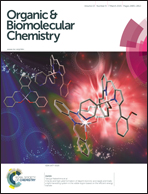A comparison of chemiluminescent acridinium dimethylphenyl ester labels with different conjugation sites†
Abstract
Chemiluminescent acridinium dimethylphenyl esters are highly sensitive labels that are used in automated assays for clinical diagnosis. Light emission from these labels and their conjugates is triggered by treatment with alkaline peroxide. Conjugation of acridinium ester labels is normally done at the phenol. During the chemiluminescent reaction of these acridinium esters, the phenolic ester is cleaved and the light emitting acridone moiety is liberated from its conjugate partner. In the current study, we report the synthesis of three new acridinium esters with conjugation sites at the acridinium nitrogen and compare their properties with that of a conventional acridinium ester with a conjugation site at the phenol. Our study is the first that provides a direct comparison of the emissive properties of acridinium dimethylphenyl esters (free labels and protein conjugates) with different conjugation sites, one where the light emitting acridone remains attached to its conjugate partner versus conventional labeling which results in cleavage of the acridone from the conjugate. Our results indicate that the conjugation at the acridinium nitrogen, which also alters how the acridinium ring and phenol are oriented with respect to the protein surface, has a minimal impact on emission kinetics and emission spectra. However, this mode of conjugation to three different proteins led to a significant increase in light yield which should be useful for improving the assay sensitivity.


 Please wait while we load your content...
Please wait while we load your content...